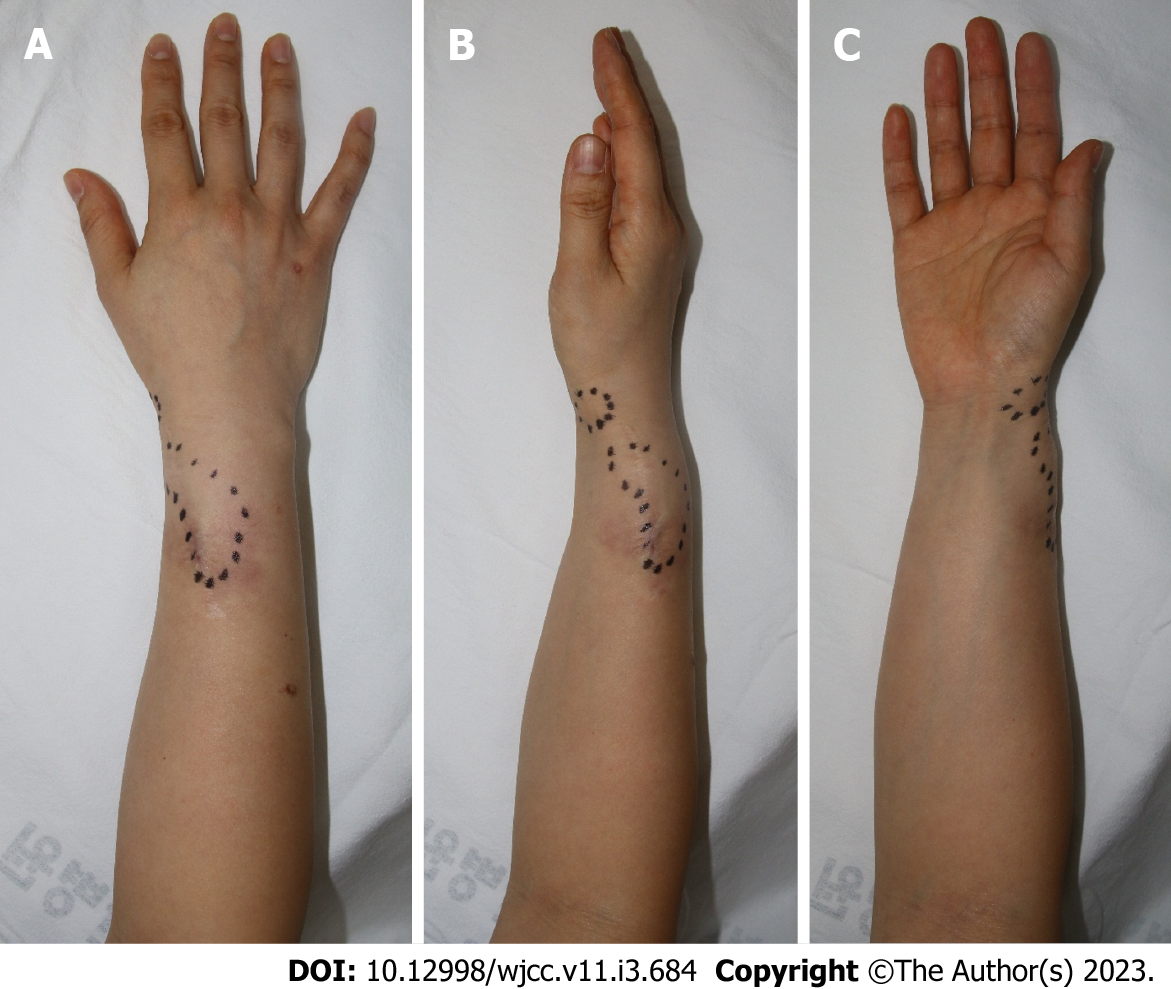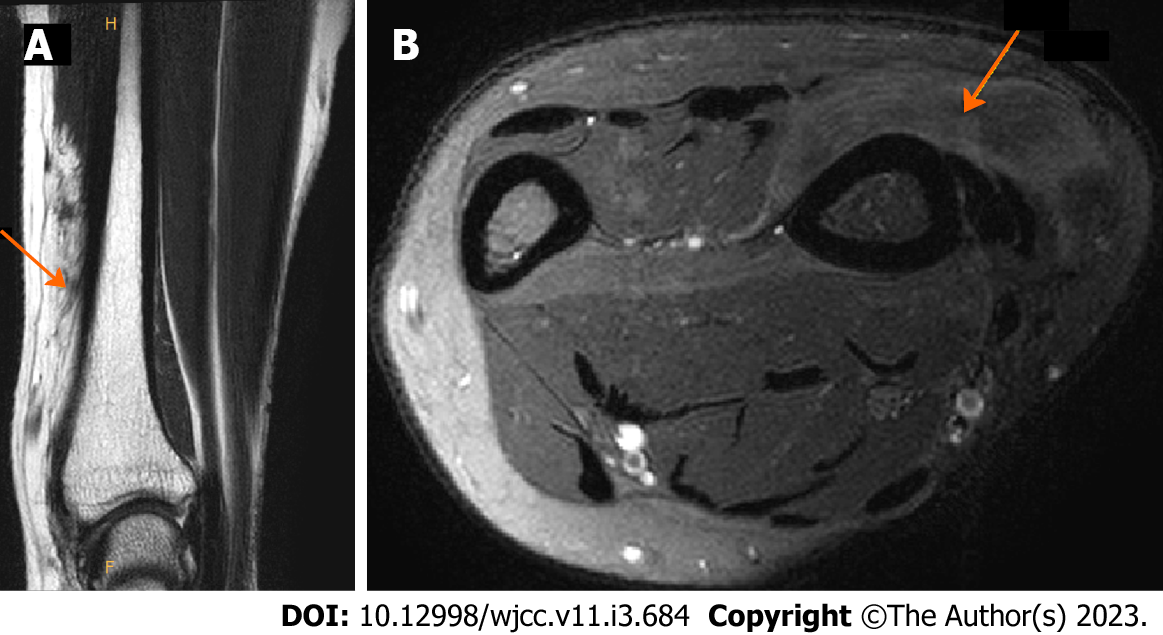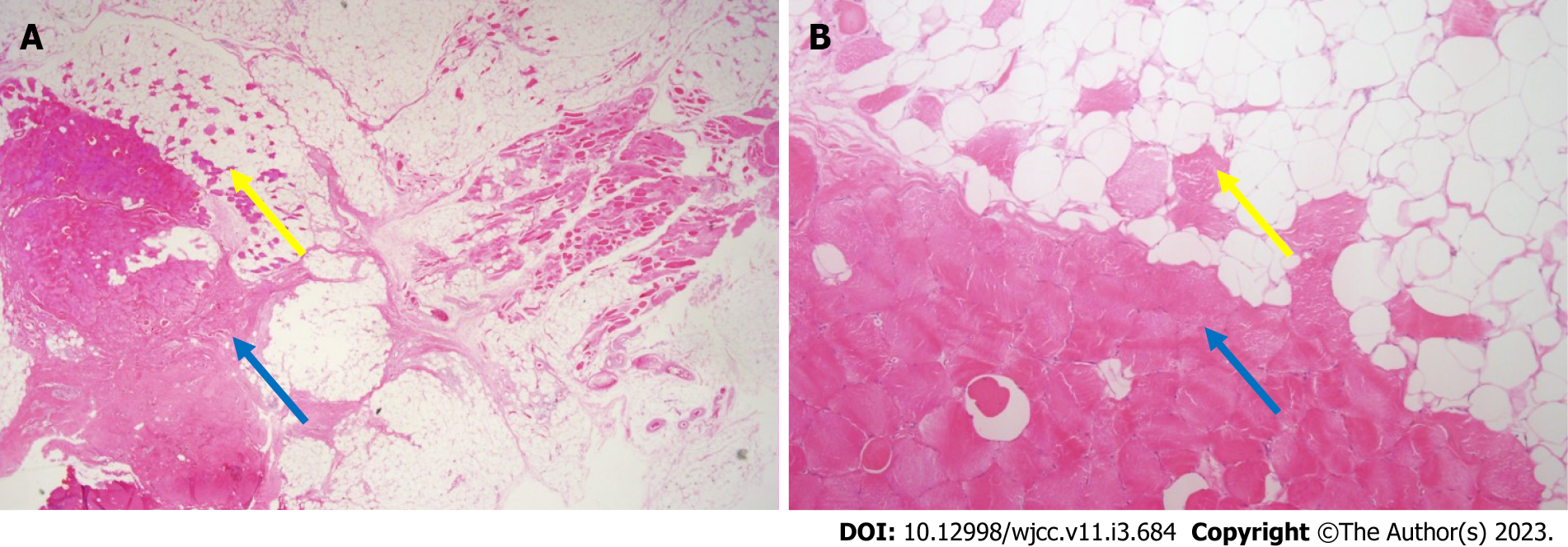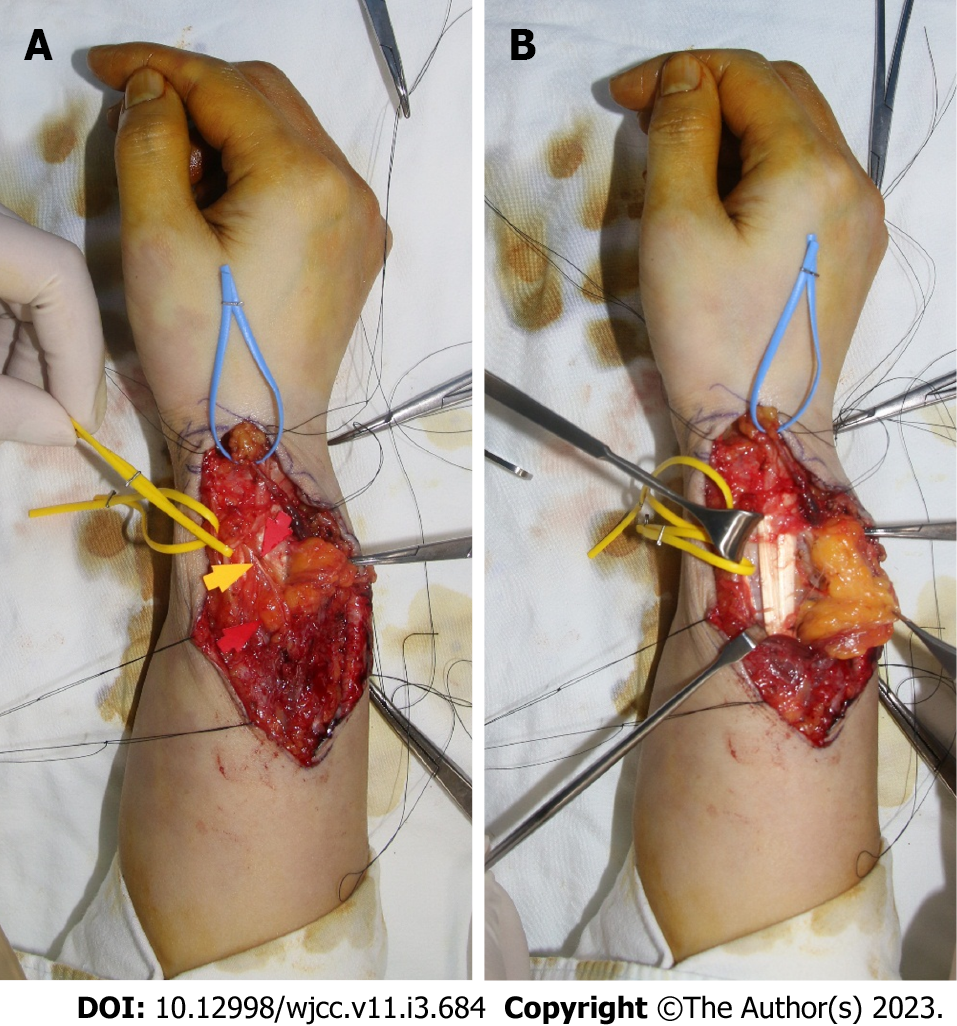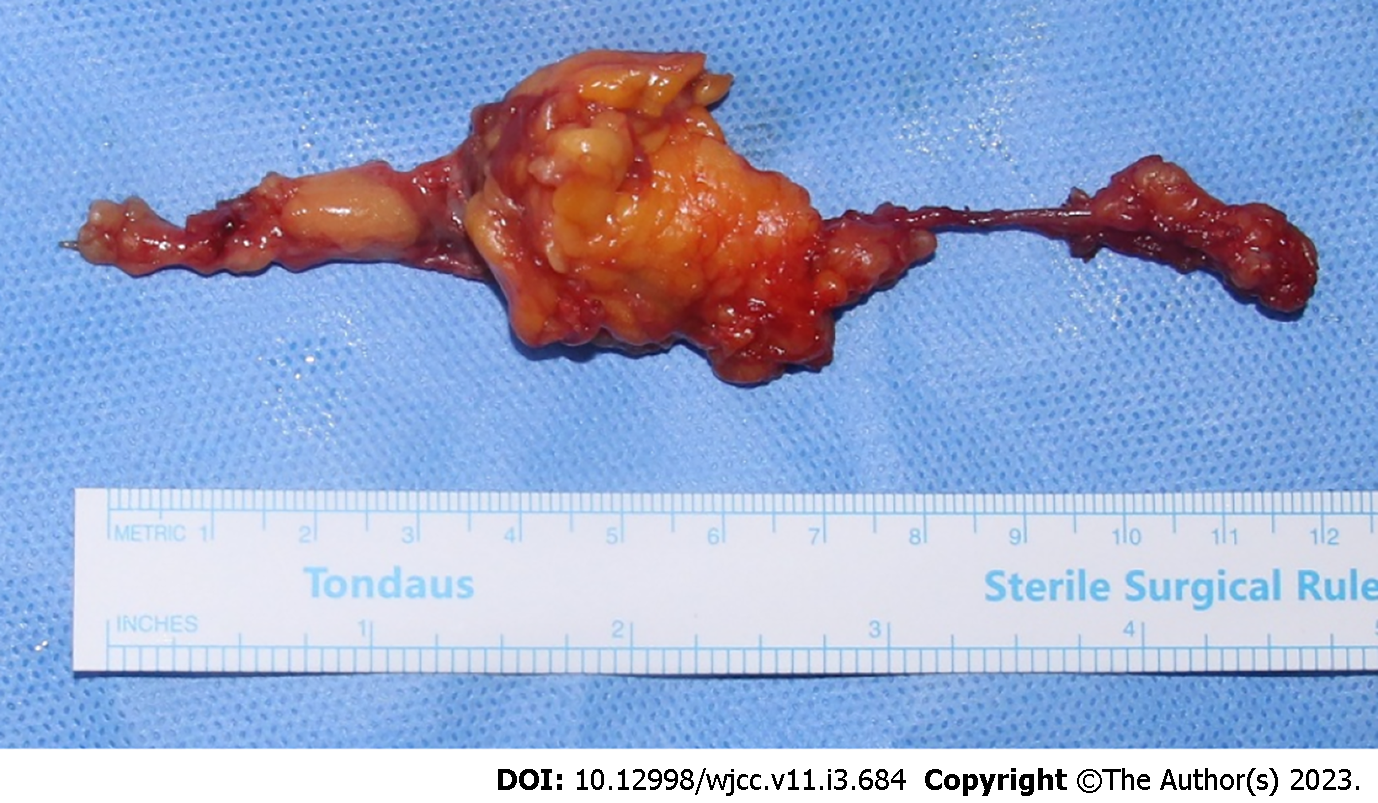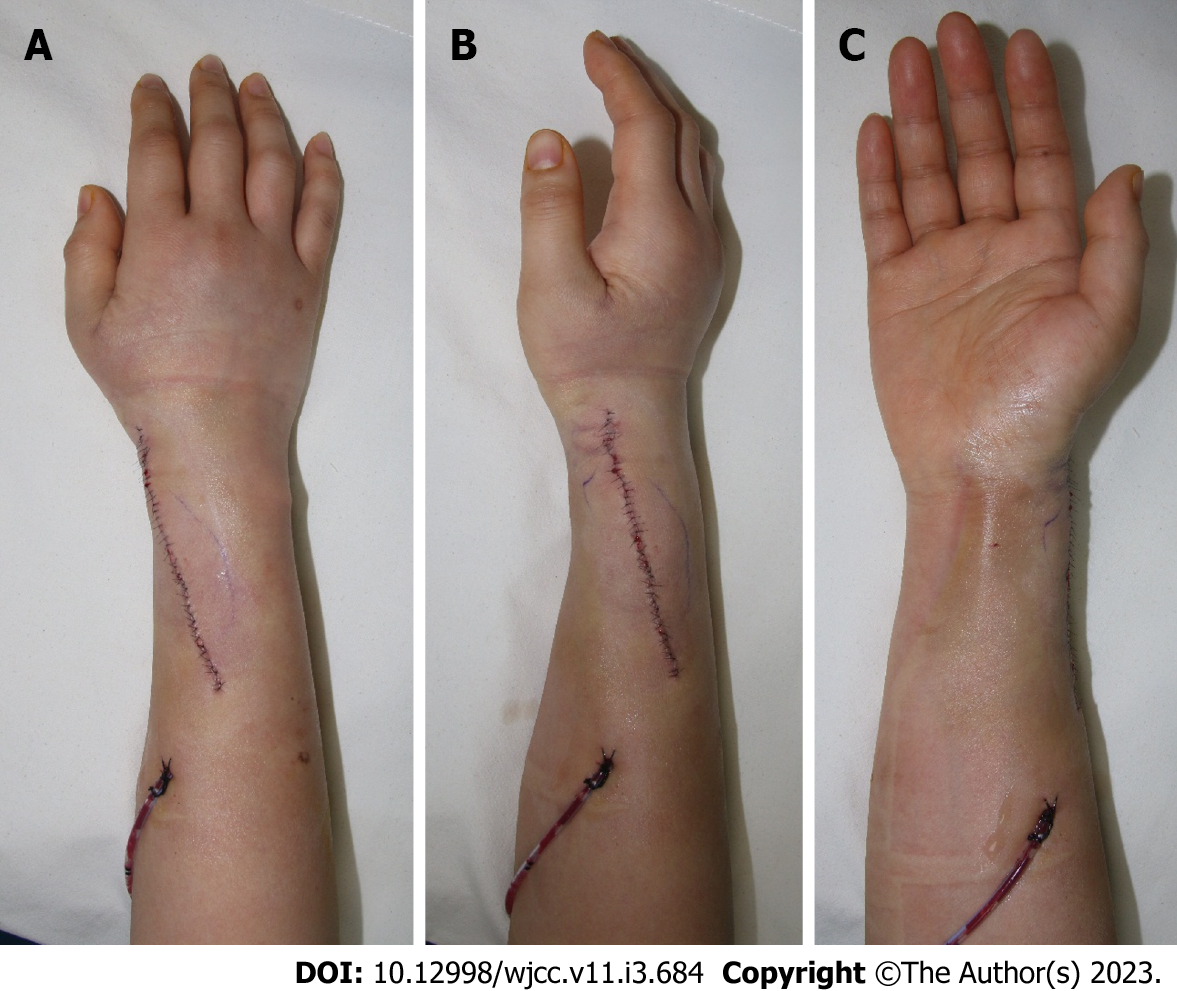Published online Jan 26, 2023. doi: 10.12998/wjcc.v11.i3.684
Peer-review started: November 1, 2022
First decision: December 13, 2022
Revised: December 14, 2022
Accepted: January 9, 2023
Article in press: January 9, 2023
Published online: January 26, 2023
Processing time: 86 Days and 2.8 Hours
This report describes and discusses recurrent intramuscular lipoma (IML) of the extensor pollicis brevis (EPB). An IML usually occurs in a large muscle of the limb or torso. Recurrence of IML is rare. Recurrent IMLs, especially those with unclear boundaries, necessitate complete excision. Several cases of IML in the hand have been reported. However, recurrent IML appearing along the muscle and tendon of EPB on wrist and forearm has not been reported yet.
In this report, the authors describe clinical and histopathological features of recurrent IML at EPB. A 42-year-old Asian woman presented with a slow-growing lump in her right forearm and wrist area six months ago. The patient had a history of surgery for a lipoma of the right forearm one year ago with a scar of 6 cm on the right forearm. magnetic resonance imaging confirmed that the lipomatous mass, which had attenuation similar to subcutaneous fat, had invaded the muscle layer of EPB. Excision and biopsy were performed under general anesthesia. On histological examination, it was identified as an IML showing mature adipocytes and skeletal muscle fibers. Therefore, surgery was terminated without further resection. No recurrence occurred during a follow-up of five years after surgery.
Recurrent IML in the wrist must be examined to differentiate it from sarcoma. Damage to surrounding tissues should be minimized during excision.
Core Tip: Lipoma is one of the most common benign tumors. Intramuscular lipoma (IML) is a lipoma that has invaded the muscular layer, sometimes with unclear boundaries. It may recur if complete resection is not performed. IMLs that recur with unclear boundaries might need to be differentiated from soft tissue sarcoma. Therefore, imaging tests such as computed tomography or magnetic resonance imaging should be performed before surgery and a thorough preoperative plan should be established to reduce recurrence and preserve hand function.
- Citation: Byeon JY, Hwang YS, Lee JH, Choi HJ. Recurrent intramuscular lipoma at extensor pollicis brevis: A case report. World J Clin Cases 2023; 11(3): 684-691
- URL: https://www.wjgnet.com/2307-8960/full/v11/i3/684.htm
- DOI: https://dx.doi.org/10.12998/wjcc.v11.i3.684
A lipoma is a common benign mesenchymal tumor that can occur anywhere in our body. It is one of the most common soft tissue tumors[1]. Lipomas are usually capsulized and well distinguished from surrounding subcutaneous adipose tissues. However, when they infiltrate structures such as muscles, nerves, or synovium, they are less circumscribed and not-well-distinguished from surrounding tissues than usual lipoma. Among them, cases of invasion of the muscle layer are called intramuscular lipoma (IML) or infiltrating lipoma[2]. As reported in several cases, IML usually occurs in a large muscle of the limb or torso[3-8]. To treat an IML, complete removal including capsules is performed, similar to conventional lipoma treatment methods. However, of all IMLs, 83% are infiltrative and 17% are well-defined. In case of infiltrative IML, it is difficult to distinguish from surrounding tissues[4]. There are also important structures around the periphery of the IML that can make it difficult to achieve complete excision. There is a possibility of recurrence if there is no complete excision[5,8]. Additionally, it might be difficult to differentiate a recurrent IML from well-differentiated liposarcoma, because an IML is clinically or histologically indistinguishable from a well-differentiated liposarcoma[4,9]. Therefore, it is important to perform a preoperative radiology examination. Magnetic resonance imaging (MRI) is a device that can effectively diagnose lipoma. It can also help diagnose IML[10]. In this report, the authors report a recurrent IML in the extensor pollicis brevis (EPB) muscle treated surgically without showing any signs of recurrence after five years of follow-up.
A 42-year-old Asian woman presented with a slow-growing lump in her right forearm and wrist area six months ago.
Symptoms started six months ago with a recurrent lump on the previous operative wounds of wrist and forearm.
The patient had a history of surgery with a lipoma of the right forearm one year ago and had a scar of 6 cm on the right forearm. There was no other medical history or surgical history.
The patient denied any family history of tumors.
Soft, painless lumps along the EPB of the right thumb were found on physical examination. One had a size of 1 cm × 2 cm in the medial area of the right wrist. One had a size of 2 cm × 5 cm on the medial side of the forearm. Her sensation of fingers and wrists, range of motion, and motor power were all normal (Figure 1).
There were no specific findings in laboratory examinations.
MRIs showed lumps in muscles and ligaments of EPB that appeared to be due to fat attenuation. Invaded muscles and ligaments showed unclear boundaries (Figure 2).
Biopsy results also confirmed the IML of EPB (Figure 3).
General anesthesia was performed with inhalation anesthesia using sevoflurane after induction using intravascular propofol. After drawing a longitudinal 12 cm incision along the path of the EPB and previous scars, incision was performed with No 15-scalpel blade. Intact presence of the superficial radial nerve and artery running next to the EPB was confirmed. After meticulous dissection of adjacent normal tissues (including muscles, ligaments, nerves, blood vessels, etc.), the IML was exposed using sharp mosquito. A lipomatous mass with a lobulated aspect measuring 12 cm × 4 cm × 5 cm was invading muscles and ligaments (Figures 4 and 5). Blunt Metzenbaum scissor and electrocautery were then used to remove the mass. 200cc HemoVAC was inserted after normal saline irrigation. The superficial fascia and subcutaneous layer were sutured layer by layer with 4-0 Maxon and the skin was sutured with 5-0 Nylon.
Immediately after the surgery, her sensory function was intact and circulation was well maintained (Figure 6). Her extension power was slightly weakened by partial excision of the EPB. However, her extension function was preserved. After 5 years of follow-up, there were no recurrences, side effects, or functional limitations.
An IML can be distinguished from a conventional lipoma by its rarity and its clinical and pathological characteristics[2]. Histologically, IML can be divided into an infiltrative type, a well-circumscribed type, and a mixed type. Among them, the infiltrative type of IML has distinctive features[11-13]. Clinically, IMLs are characterized by a slow-growing mass that is asymptomatic or accompanied by local edema. Pain is a rare symptom that appears at the end of the course of the disease. It can occur when a deep, huge lipoma causes nerve compression with a mass effect or compresses surrounding soft tissues[12]. In some cases, it has been reported that IML itself is associated with functional limitation of muscles[13,14]. Paresthesia and nerve distribution caused by nerve impingement are also among symptoms that might appear[15,16]. Trauma, chronic irritation, obesity, developmental disorders, endocrine, dysmetabolic factors, and genetic factors have been suggested to play roles in the pathogenesis of IML[17-19].
Papakostas et al[6] have reported cases of IML of the thenar. Lui[7] have reported cases of IML occurring in the abductor digiti minimi. Kim et al[1] have presented a lipoma occurring in the flexor tenosynovium. Kostas-Agnantis et al[20] have reported a lipoma case in the palmaris longus tendon. Lee et al[15] have reported cases of IML occurring in thenar and hypothenar area. However, cases of recurrent IML involving both extensor muscle and tendinous portion at the wrist and forearm level have not been reported yet.
Murphey et al[10] have stated that there is no possibility of malignant transformation of lipomas. It was often claimed that the reports were probably sampling errors or misdiagnoses.
Currently, the recurrence rate of IML is believed to be very low[21]. The patient in this case had previously undergone a surgery. However, it was not completely removed during the previous operation, which might have led to the recurrent. Therefore, attention should be paid to complete excision to reduce the possibility of recurrence and to exclude the possibility of malignancy. By minimizing trauma and meticulous dissection during the surgical procedure, both nerves and blood vessels were preserved with only the area with lipoma invasion removed. The patient has been observed for five years without showing any signs of recurrence.
Computed tomography scan and MRI are both useful for detecting IML and evaluating its invasion in surrounding tissues[10,22]. On computed tomography (CT) scan, IML in the muscle shows a hypodense mass, similar to dense subcutaneous fat[23]. Its morphology can vary widely, ranging from ovoid to fusiform. Its margin might be well-circumscribed or infiltrative[24]. In MRI, IML appears to show a high signal in both T1 and T2, similar to fatty tissue with low signal similar to normal fat in fat-suppressed sequences[10]. MRI can identify IML more specifically than CT. However, results seen on the image might not be exactly the same as actual histological examination results[10].
Histopathologic exam is one of the essential tests for diagnosis. In most cases, there is a uniform appearance of mature uni-vacuolated adipocytes with uniform size and shape. In rare cases, IML can invade muscles, fascia, and tendon[11]. Histological and cytological analyses of IML are extremely important for differentiating it from well-differentiated liposarcoma. Well-differentiated liposarcomas differ from normal IMLs in the presence of atypical cells, vacuolated lipoblasts admixed with fibroblasts-like spindle cells, and several other features[25].
In conclusion, considering that IML can occur and recur in hand muscles as observed in this case, careful physical examination and imaging examination should be performed before surgery to diagnose it and completely remove it to reduce the recurrence rate. Additionally, since hands have many important structures, careful attention should be paid to effectively removing the IML s while preserving surrounding nerves, blood vessels, and ligaments.
Provenance and peer review: Unsolicited article; Externally peer reviewed.
Peer-review model: Single blind
Specialty type: Medicine, research and experimental
Country/Territory of origin: South Korea
Peer-review report’s scientific quality classification
Grade A (Excellent): 0
Grade B (Very good): B
Grade C (Good): C
Grade D (Fair): 0
Grade E (Poor): 0
P-Reviewer: Alfaqih MS, Indonesia; Singh M, United States S-Editor: Fan JR L-Editor: A P-Editor: Fan JR
| 1. | Kim HW, Lee KJ, Choi SK, Jang IT, Lee HJ. A large palmar lipoma arising from flexor tenosynovium of the hand causing digital nerve compression: A case report. Jt Dis Relat Surg. 2021;32:230-233. [RCA] [PubMed] [DOI] [Full Text] [Full Text (PDF)] [Cited by in Crossref: 1] [Cited by in RCA: 1] [Article Influence: 0.3] [Reference Citation Analysis (0)] |
| 2. | Charifa A, Azmat CE, Badri T. Lipoma Pathology. 2022 Dec 5. In: StatPearls [Internet]. Treasure Island (FL): StatPearls Publishing; 2022 Jan-. [PubMed] |
| 3. | Wolfe SW, Bansal M, Healey JH, Ghelman B. Computed tomographic evaluation of fatty neoplasms of the extremities. A clinical, radiographic, and histologic review of cases. Orthopedics. 1989;12:1351-1358. [RCA] [PubMed] [DOI] [Full Text] [Cited by in Crossref: 9] [Cited by in RCA: 9] [Article Influence: 0.3] [Reference Citation Analysis (0)] |
| 4. | McTighe S, Chernev I. Intramuscular lipoma: a review of the literature. Orthop Rev (Pavia). 2014;6:5618. [RCA] [PubMed] [DOI] [Full Text] [Full Text (PDF)] [Cited by in Crossref: 43] [Cited by in RCA: 65] [Article Influence: 5.9] [Reference Citation Analysis (0)] |
| 5. | Khalfe Y, Orengo I, Buren GV, Rosen T. Intramuscular lipoma of the scapular region. Dermatol Online J. 2021;27. [RCA] [PubMed] [DOI] [Full Text] [Reference Citation Analysis (0)] |
| 6. | Papakostas T, Tsovilis AE, Pakos EE. Intramuscular Lipoma of the Thenar: A Rare Case. Arch Bone Jt Surg. 2016;4:80-82. [PubMed] |
| 7. | Lui TH. Intramuscular lipoma of the abductor digiti minimi mimicking intramuscular haemangioma. BMJ Case Rep. 2013;2013. [RCA] [PubMed] [DOI] [Full Text] [Cited by in Crossref: 3] [Cited by in RCA: 4] [Article Influence: 0.3] [Reference Citation Analysis (0)] |
| 8. | Su CH, Hung JK, Chang IL. Surgical treatment of intramuscular, infiltrating lipoma. Int Surg. 2011;96:56-59. [RCA] [PubMed] [DOI] [Full Text] [Cited by in Crossref: 22] [Cited by in RCA: 29] [Article Influence: 2.1] [Reference Citation Analysis (0)] |
| 9. | Ohguri T, Aoki T, Hisaoka M, Watanabe H, Nakamura K, Hashimoto H, Nakamura T, Nakata H. Differential diagnosis of benign peripheral lipoma from well-differentiated liposarcoma on MR imaging: is comparison of margins and internal characteristics useful? AJR Am J Roentgenol. 2003;180:1689-1694. [RCA] [PubMed] [DOI] [Full Text] [Cited by in Crossref: 111] [Cited by in RCA: 94] [Article Influence: 4.3] [Reference Citation Analysis (0)] |
| 10. | Murphey MD, Carroll JF, Flemming DJ, Pope TL, Gannon FH, Kransdorf MJ. From the archives of the AFIP: benign musculoskeletal lipomatous lesions. Radiographics. 2004;24:1433-1466. [RCA] [PubMed] [DOI] [Full Text] [Cited by in Crossref: 417] [Cited by in RCA: 372] [Article Influence: 18.6] [Reference Citation Analysis (0)] |
| 11. | Kindblom LG, Angervall L, Stener B, Wickbom I. Intermuscular and intramuscular lipomas and hibernomas. A clinical, roentgenologic, histologic, and prognostic study of 46 cases. Cancer. 1974;33:754-762. [PubMed] [DOI] [Full Text] |
| 12. | Patil S, Goel A, Mandal S. Re: Morsi HA, Mursi K, Abdelaziz AY, Elsheemy MS, Salah M, Eissa MA. Renal pelvis reduction during dismembered pyeloplasty: is it necessary? J Pediatr Urol. 2013;9:306-307. [RCA] [PubMed] [DOI] [Full Text] [Cited by in Crossref: 1] [Reference Citation Analysis (0)] |
| 13. | Han HH, Choi JY, Seo BF, Moon SH, Oh DY, Ahn ST, Rhie JW. Treatment for intramuscular lipoma frequently confused with sarcoma: a 6-year restrospective study and literature review. Biomed Res Int. 2014;2014:867689. [RCA] [PubMed] [DOI] [Full Text] [Full Text (PDF)] [Cited by in Crossref: 11] [Cited by in RCA: 16] [Article Influence: 1.5] [Reference Citation Analysis (0)] |
| 14. | Warner JJ, Madsen N, Gerber C. Intramuscular lipoma of the deltoid causing shoulder pain. Report of two cases. Clin Orthop Relat Res. 1990;110-112. [PubMed] |
| 15. | Lee YH, Jung JM, Baek GH, Chung MS. Intramuscular lipoma in thenar or hypothenar muscles. Hand Surg. 2004;9:49-54. [RCA] [PubMed] [DOI] [Full Text] [Cited by in Crossref: 11] [Cited by in RCA: 10] [Article Influence: 0.5] [Reference Citation Analysis (0)] |
| 16. | Joshua BZ, Bodner L, Shaco-Levy R. Intramuscular (Infiltrating) Lipoma of the Floor of the Mouth. Case Rep Med. 2018;2018:3529208. [RCA] [PubMed] [DOI] [Full Text] [Full Text (PDF)] [Cited by in Crossref: 2] [Cited by in RCA: 2] [Article Influence: 0.3] [Reference Citation Analysis (0)] |
| 17. | Awad P. Rare Intramuscular Lipoma of the Foot: A Case Report. J Am Podiatr Med Assoc. 2021;111. [RCA] [PubMed] [DOI] [Full Text] [Cited by in Crossref: 1] [Cited by in RCA: 2] [Article Influence: 0.5] [Reference Citation Analysis (0)] |
| 18. | Pichierri A, Marotta N, Raco A, Delfini R. Intramuscular infiltrating lipoma of the longus colli muscle. a very rare cause of neck structures compression. Cent Eur Neurosurg. 2010;71:157-159. [RCA] [PubMed] [DOI] [Full Text] [Cited by in Crossref: 5] [Cited by in RCA: 5] [Article Influence: 0.3] [Reference Citation Analysis (0)] |
| 19. | Copcu E. Can intramuscular lipoma have a post-traumatic origin? Br J Dermatol. 2003;149:1084-1085. [RCA] [PubMed] [DOI] [Full Text] [Cited by in Crossref: 12] [Cited by in RCA: 15] [Article Influence: 0.7] [Reference Citation Analysis (0)] |
| 20. | Kostas-Agnantis I, Gkiatas I, Korompilia M, Kosmas D, Motsis E, Pakos E, Korompilias A. Lipoma Arborescens of the Upper Extremity With Anatomic Variation of the Palmaris Longus: A Case Report. JBJS Case Connect. 2022;12. [RCA] [PubMed] [DOI] [Full Text] [Cited by in Crossref: 1] [Cited by in RCA: 1] [Article Influence: 0.3] [Reference Citation Analysis (0)] |
| 21. | Ramos-Pascua LR, Guerra-Álvarez OA, Sánchez-Herráez S, Izquierdo-García FM, Maderuelo-Fernández JÁ. [Intramuscular lipomas: Large and deep benign lumps not to underestimated. Review of a series of 51 cases]. Rev Esp Cir Ortop Traumatol. 2013;57:391-397. [RCA] [PubMed] [DOI] [Full Text] [Cited by in Crossref: 3] [Cited by in RCA: 11] [Article Influence: 0.9] [Reference Citation Analysis (0)] |
| 22. | Stacy GS, Bonham J, Chang A, Thomas S. Soft-Tissue Tumors of the Hand-Imaging Features. Can Assoc Radiol J. 2020;71:161-173. [RCA] [PubMed] [DOI] [Full Text] [Cited by in Crossref: 15] [Cited by in RCA: 15] [Article Influence: 3.0] [Reference Citation Analysis (0)] |
| 23. | Pant R, Poh AC, Hwang SG. An unusual case of an intramuscular lipoma of the pectoralis major muscle simulating a malignant breast mass. Ann Acad Med Singap. 2005;34:275-276. [PubMed] |
| 24. | Naruse T, Yanamoto S, Yamada S, Rokutanda S, Kawakita A, Takahashi H, Matsushita Y, Hayashida S, Imayama N, Morishita K, Yamashita K, Kawasaki G, Umeda M. Lipomas of the oral cavity: clinicopathological and immunohistochemical study of 24 cases and review of the literature. Indian J Otolaryngol Head Neck Surg. 2015;67:67-73. [RCA] [PubMed] [DOI] [Full Text] [Cited by in Crossref: 24] [Cited by in RCA: 29] [Article Influence: 2.6] [Reference Citation Analysis (0)] |
| 25. | Evans HL, Soule EH, Winkelmann RK. Atypical lipoma, atypical intramuscular lipoma, and well differentiated retroperitoneal liposarcoma: a reappraisal of 30 cases formerly classified as well differentiated liposarcoma. Cancer. 1979;43:574-584. [RCA] [PubMed] [DOI] [Full Text] [Cited by in RCA: 1] [Reference Citation Analysis (0)] |









